|

Bolivia
The
procedures for both sides, passports and
custom took about one hour, the we drove on.
Our carnet is a miracle worker with
customs. They fill it out, put dates in the computer, sign it, tear
a slip away, and JAMBO is in Bolivia..

driving in Bolivia, the day was fading
away
The road conditions had changed. While we enjoyed in Argentina
tarred autopistas, here it was bare gravel,
washboards surface and
occasionally big
stones. No more signboards, we just drove
on. At a later stage the road was under
construction and numerous
diversions did not
easy the travel. Construction lorries at
night still working blocked sometime the
road. We went through an
unfinished tunnel
were held up by a rope because of toll until
around 9:00 PM we reached a village which
had much to our surprise
streetlights and a
hotel. Happy we set for the night after JAMBO was securely parked in the compound.
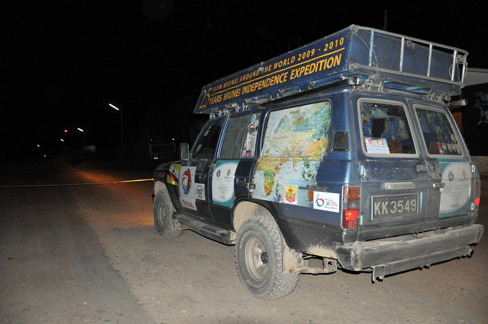
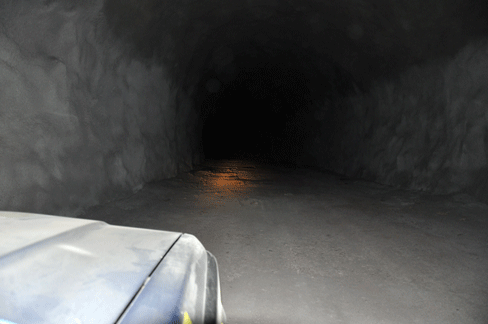
The "Toll Gate" a string
unfinished tunnel, see the dust on JAMBO
FRIDAY 18-6-2010
The cold morning wacked us as there was no heater in the hotel room and so
we left town early. People were already on
the road.
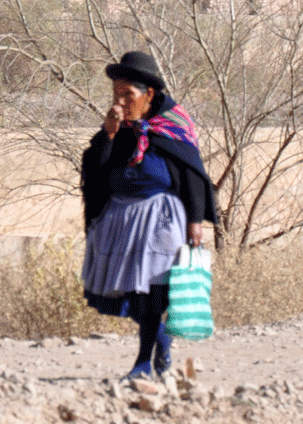
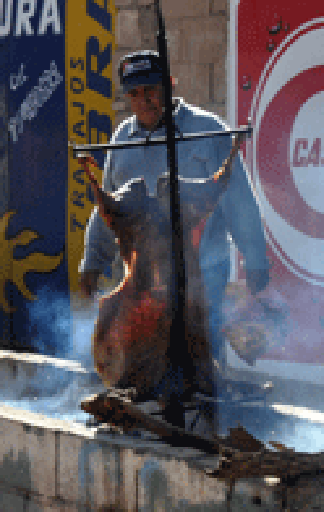
An elderly Indian maiden early he span a sheep over a fire to be
ready in the evening
A signboard on the
outskirt informed that it was only 200 km
until UYUNI, the town on the very saltpan we
wanted to see. We had as
always filled JAMBO
to the rim and it was wise, as there was no
fuel available. Bone-dry petrol stations.
What a road! A narrow
rollercoaster ride in
gear one two and only a few times in three.
It took us 6½ hours. 200 km only! Yes, through
landscape
unimaginable. We were deep in the
Andes. Let us share with you some of these
exceptional beautiful scenes.
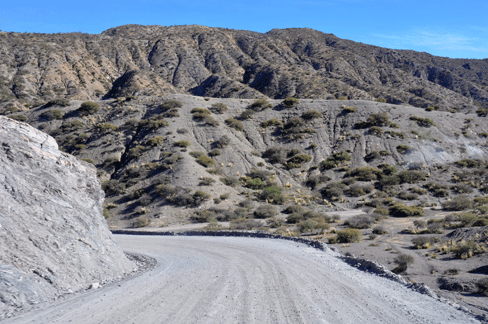
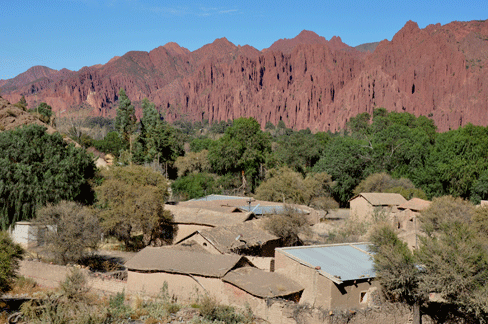
The
land is generally dry, only in depressions
and valleys between high mountains, where
water accumulates and begins to flow.
Supplied by springs which just come out of the vertical cliff.
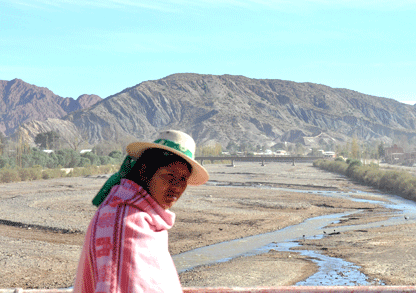
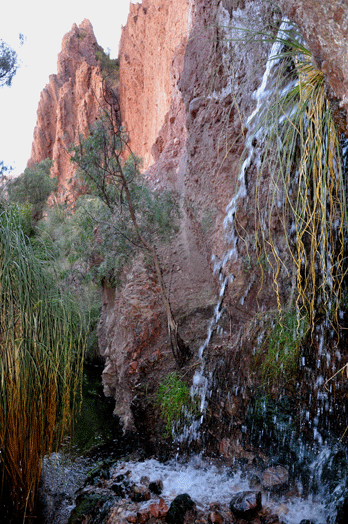
a riverbed
cool water rushes out of a natural hole
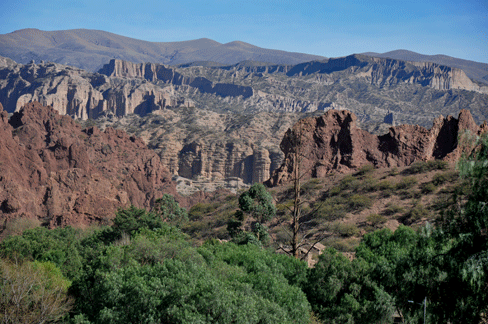

The
200 km we were steadily climbing on a narrow
gravel road. A devilishly northwesterly was
blowing pulling the vehicle door almost
out of the hands. And it was freezing cold up here.
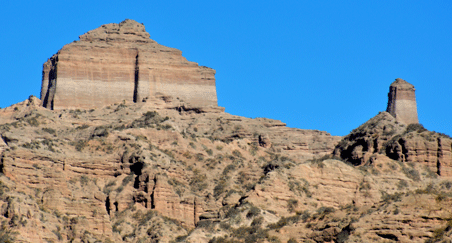
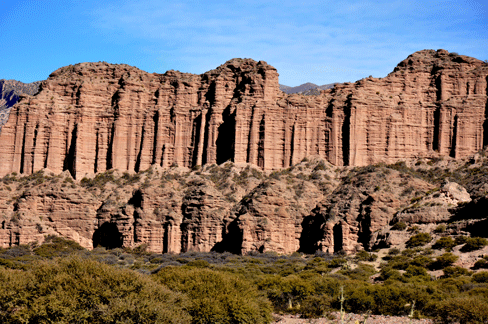
Two
castles of the "mountains spirits"
The rocks are held by pillars, so it
seems
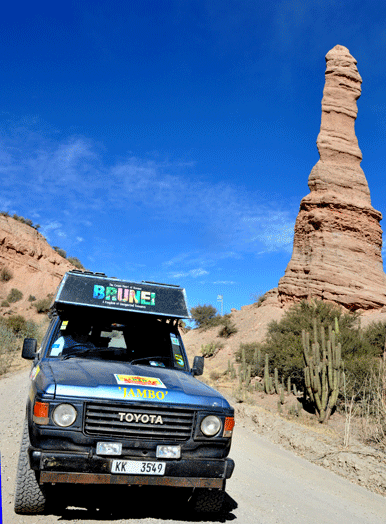
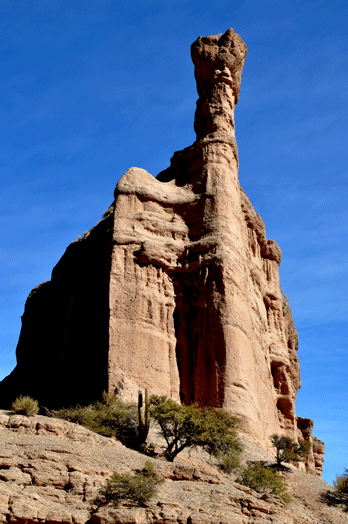
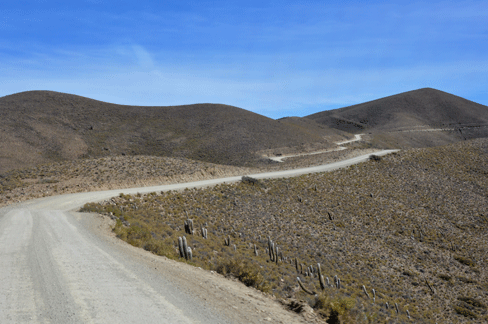
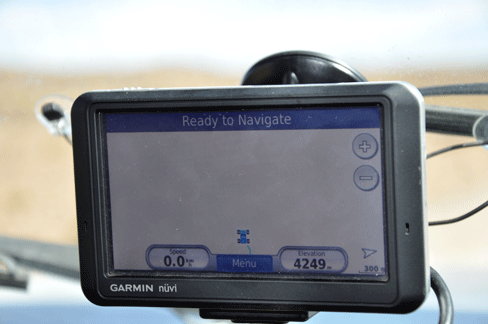
At 4,000 m and
our road still going up
4,249m; we were higher than Mt. Kinabalu
We
got both terrible headache. The face reddish
and hot, the heartbeat had accelerated
pumping faster. The body demanded oxygen
from the blood, which was not available. We both felt miserable. We
knew that are symptoms of mountain sickness
where there is
no cure except returning to lower altitudes. That was the body's
reaction to lack of oxygen. We had not taken
time for
acclimatization, and went too fast up into these heights.
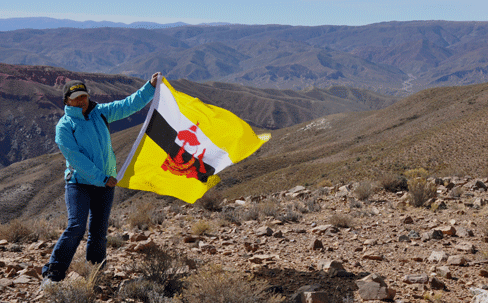
4,249 m; I found
the strength to raise our flag in the
ice-cold Andean wind
The
picture shows you dear reader, how I had to
cramp together. One could not be outside
more than a minute. For a half hour we
had to stay above 4000 m, then gradually the road tilted down
again. My belly was revolting, a feeling as
to vomit. We knew that was
a further symptom of Mountain sickness. One feels powerless. The
trouble was, if the symptoms persist or get
worst, there was no
way to go to lower altitudes. At 2000 m height was a day travel
away and in Argentina. I remembered seeing
in the border custom
office an oxygen bottle coupled to a face mask. Just in case
someone is hit by this sickness.
.


Ravines with everlasting ice
we felt relieved, seeing the road going down
We prayed and hoped that the road will decent sooner than later, up
here not much plant life anymore. The
climate and the ultraviolet
sun radiation does not permit much life.

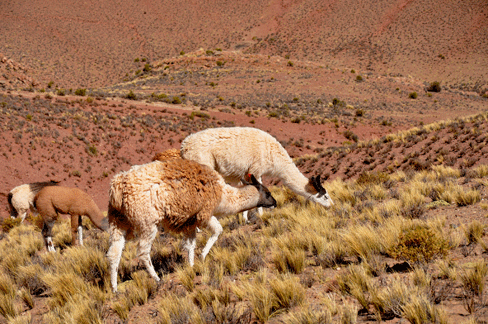
Our road leading to the horizon. With the first grass bushels
further down, the Llamas appeared, with their
thick wool properly prepared
for the harsh climate up here. Travelling on, Lamas became now a
common sight, once in a while a homestead.
Probably the owners
of the Lama herds.
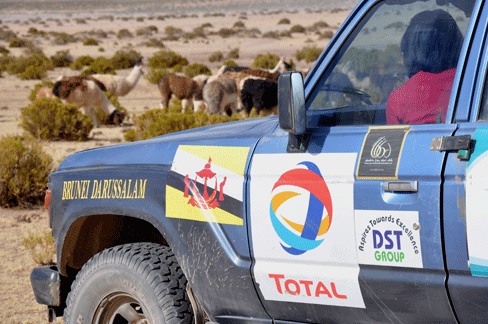
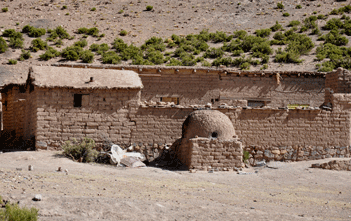
Llamas grazing at the rear
Notice the grass roofed and mud bricks build
home with a backing oven

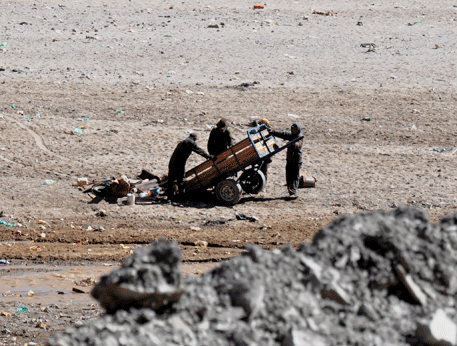
Then Tupiza town came into view. There is
nothing to report, only they had no diesel
and disposal of rubbish was done the old
fashion
way. Just dump it on the river side. However they were
visited by some famous bank robbers in 1906,
which emptied the mining
coffers, cleaning out all cash and disappeared. The names? Butch
Cassidy and Sundance Kid.
From here we turned now North west and headed for Uyuni town and
the SALAR DE UYUNI, a salt depression, a
dried up lake.
The road was wider now with road signs and Llamas off course. A few
kilometer before town we gave JAMBO a
deserved wash.
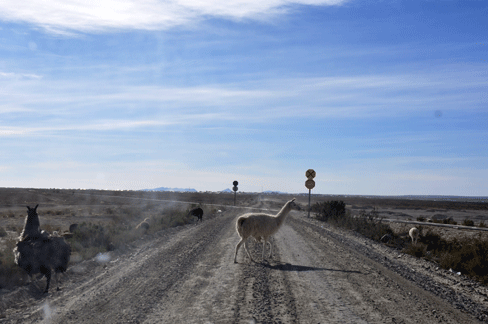
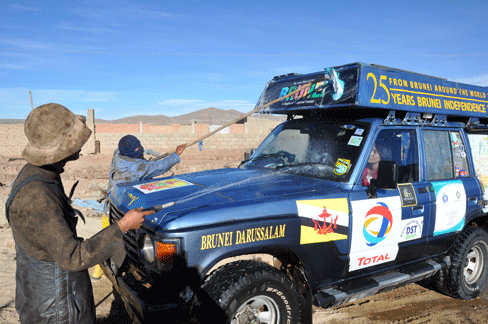
In 3600 m
height
He scrubbed hard on our Brunei Logo
The first houses came into sight. Both with terrible headache
though, we were relieved.
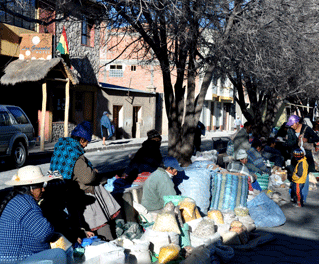
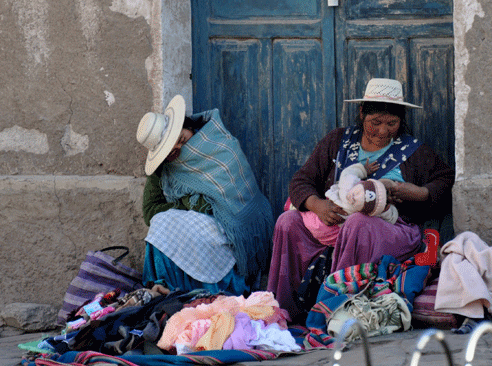
On
the bus stop, people waiting, having all
their household with them. There, a Mama
feeding her baby with the best Nature can
provide, mother milk.
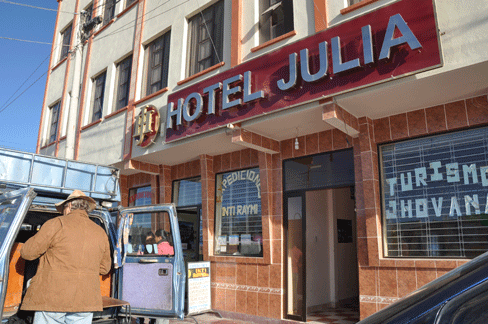
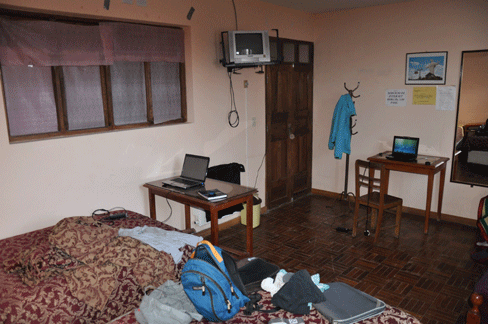
We checked into the Julia hotel for the night. And what a night it
was. First they gave us a 4 bed room for a 2
bed price. Then they
got tourists and so they knocked the door by 9:00Pm "Porfavor,
maybe we can add two persons more?" This
receptionist had crazy
ideas. But not with us.
Then the central heater in the room came only on by 8:00pm, before
it was very cold. "But then it is one the
whole night" the
receptionist confirmed. We had hot water in the evening, but non at
all in the morning.
Look at a room please. You will see some of our items and a large
window covered with gaze. On the other side
they accommodated
three "Schalom" tourist girls. Their light shone late into
the night, their blabber in Hebrew nerved
Harun until he plugged his ears and
went under the cover, still with terrible headache.
SATURDAY 19-6-2010
In
the morning no hot water, a breakfast coffee
which never saw a coffee bean. A little jam
and plenty blabber from now six "chosen
ones" as three guys had joint the maiden from Israel. We packed out
swiftly. outside it was still cold.

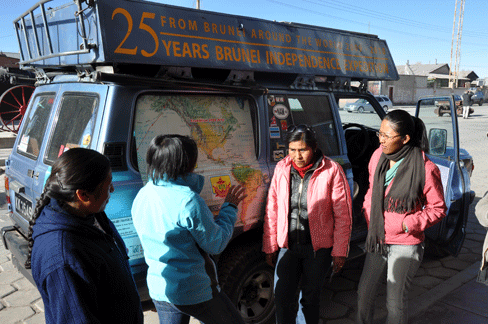
three
traveler out of Europe.
the native tour guides
You perhaps realize the cold, if the locals are dressed in thick
jackets. They, all of them tourist guides
were curious about our travel,
and therefore I had allot to explain.
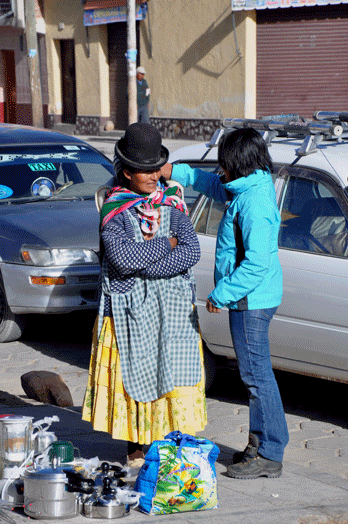
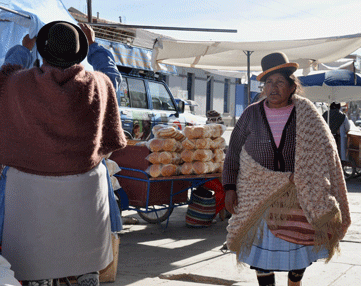
Traditional, native market traders, all
rather a bit on the round side. Maybe fat
reduces the cold. The hombug on the heads is
fashion
here and a kind of unique.

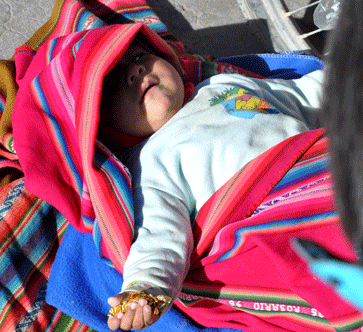
The
colorful bundle of cloth on the tar was
actually the child of the market woman,
which was selling bread on the street.
A baby's hand full bonbons, made the mother to smile.
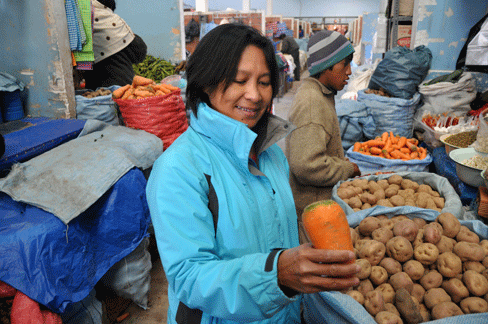
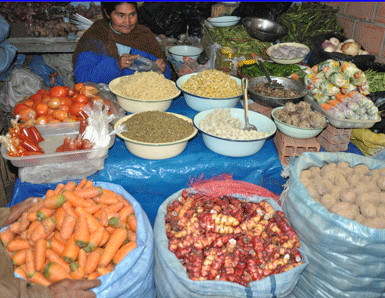
A
visit in the nearby spices and veggie market
ended our local excursion. Here I found the
biggest carrot ever seen. Then we headed
for the saltpan, only 20 minutes away.
It is impressive what exposes in front of us. A white surface
until the horizon. At the shores workers
harvested salt. We drove on, as
you can see on these pictures.
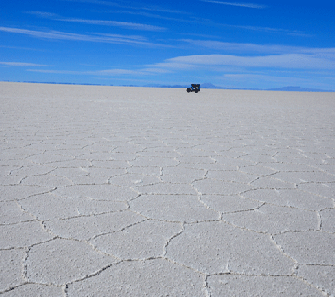
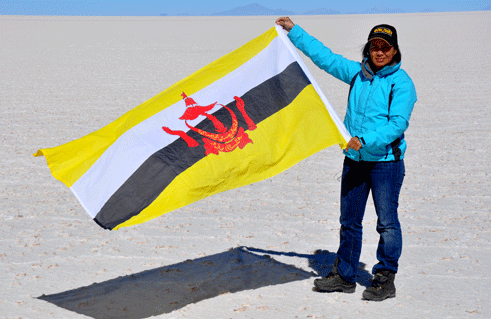
The white desert. A Vulcan nearby, is in the Aymara Mythology a
woman. And Salar de Uyuni is her milk which
flow down into the
depression. The 10.000 square km saltpan is up to 5 m thick and the
biggest Salt Lake in the world. Yearly
20,000 tons of salt are
scrubbed or hacked out yearly..
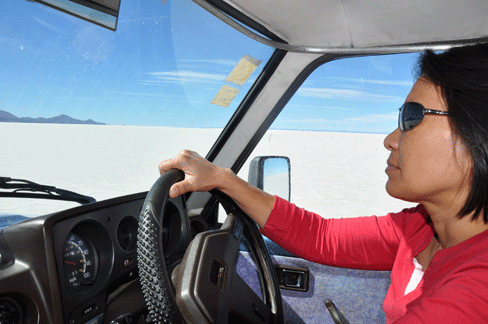

careful driving is paramount
a memory photo
The "white gold" is not only used as table
salt, but as mineral for animals, and to
preserve meat and fish.
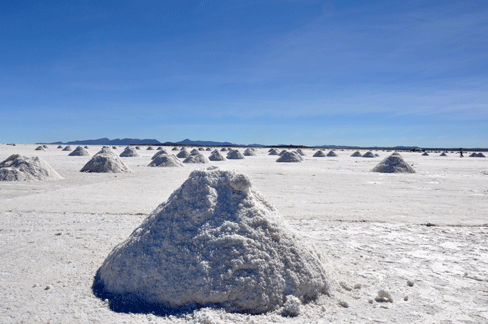
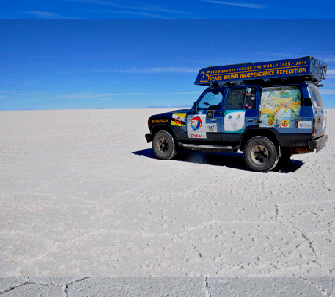
heaps of salt,
ready to be collected and transported out
JAMBO that lonely traveler
While the surface is hard and easy to drive
on, there are sections, better avoided.
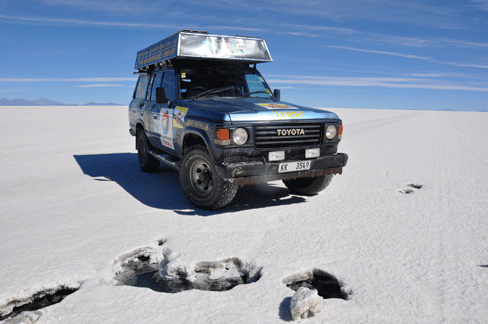
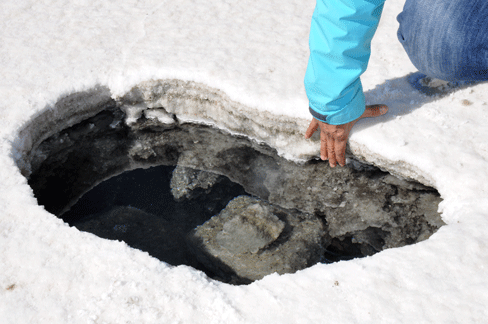
Holes in the
salt cover
salt brine below
Somewhere in the middle of the pan are some islands to which the
tour operators usually carry their tourists.
It was easy to find as
there were track marks in the salt. After about a 1½ hours it rose
in front of us and we turned in to look
around. Driving behind a cliff
there were a few vehicles parked.
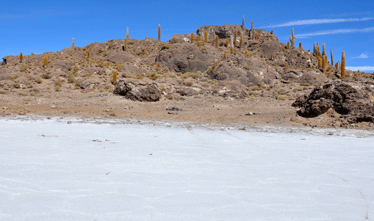

The Island
Incahuasi
coming into view
giant cactus grow on it
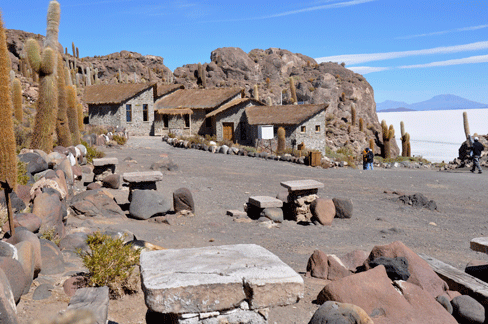
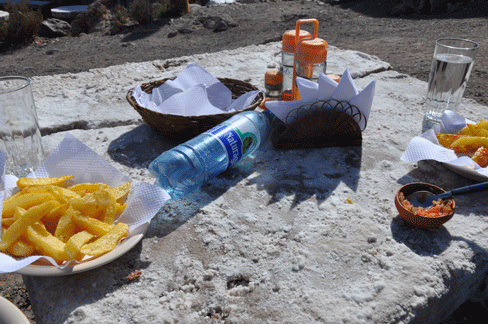
A few houses and a restaurant. Tables
outside to enjoy the view. A curiosity were
the tabletops. Look close, these are salt
blocks.
After some rather rough cut French fries, we directed JAMBO to
north and crossed the saltpan, there were no
Tour operators drive
anymore. Our direction marker was at Vulcan, the Tunapa we could
see and we headed direct towards him. After
about 35 km, we
reached the shores. What a feeling, driving with 90 km/h over the
saltpan. A hollow sound coming from the
tiers.
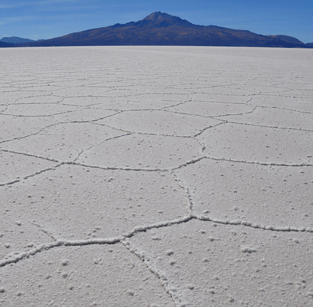
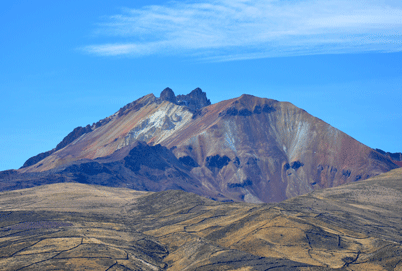 The salt plates at the horizon our direction
marker
coming closer, the Vulcan's slopes showed
several mineral colors
The salt plates at the horizon our direction
marker
coming closer, the Vulcan's slopes showed
several mineral colors
One cannot just drive to shore as there are soft patches along. The
locals had therefore made stone piles where
it is safe to leave.
You find them if your direction was right.
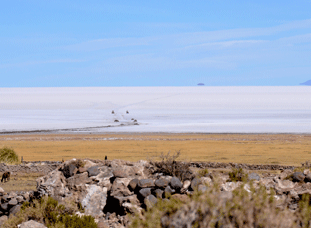
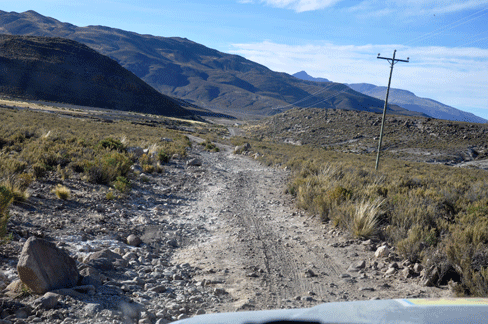
you can notice
the markers
our track for 70 km
Then we faced a track which by all accounts was terrible. True they
were later on constructing a new road, but
now was incomplete
we could not drive on. Maybe in another two years. Hours passed, we
had the first flat on the rear tire. A sharp
stone went through
the steel netting. More carefully again we went on until late
afternoon. Near a few huts, we met the
family who collected sorghum
seeds, by separating them in a sieve and then packing in 50 kg
sack.

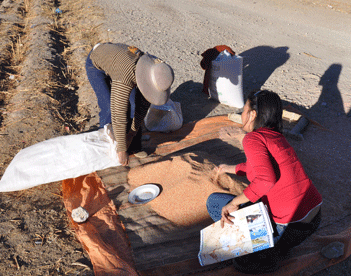
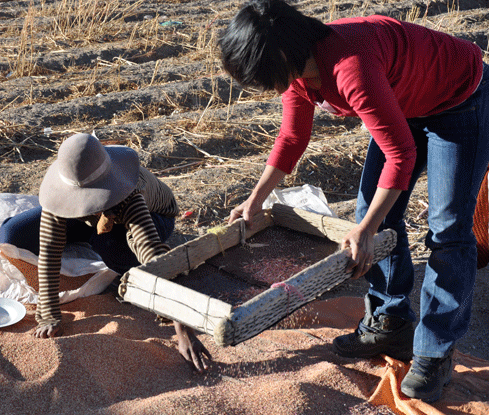
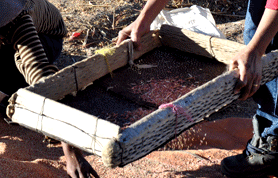
Hard work done by the simple farm folks
check the holes, the sieve is actually a
cactus tree
Driving on, at the last daylight we came to
a toll barrier. A Mama operating the string,
collecting five Bolivians about US$1.20.
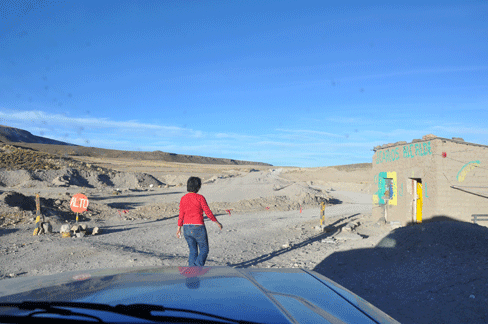
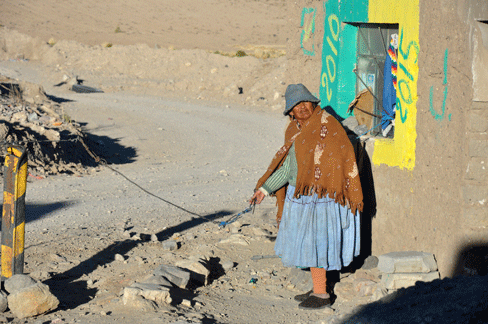
The toll barrier
ahead of us
and the toll collector
An hour later we stopped near a village as we noticed at the last
daylight a signboard "CRATER". Informing a
villager about our
intention to sleep there we went into our bags.
SUNDAY 20-6-2010
It
was a bad cold sleep. When the first
sunlight shone into JAMBO I reached for some
tea. But it was ICE TEA, meaning frozen.
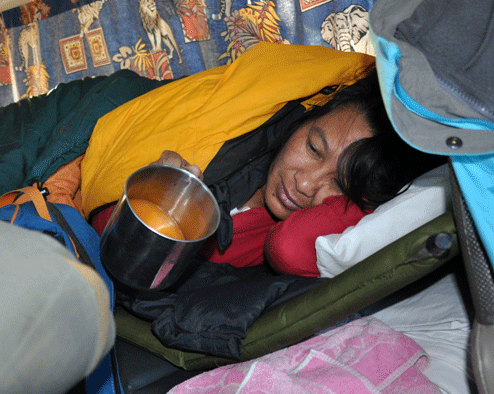
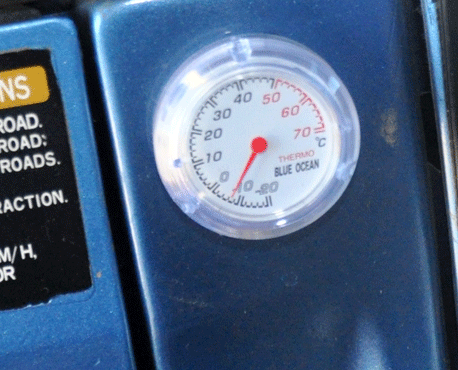
My tea ice block
minus 7 degree in the car
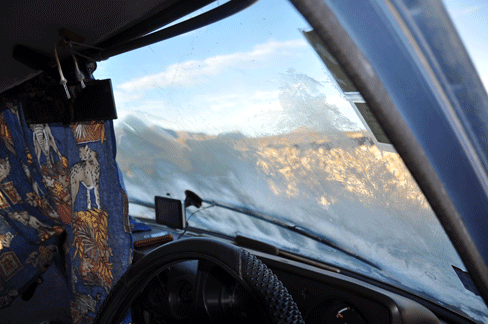
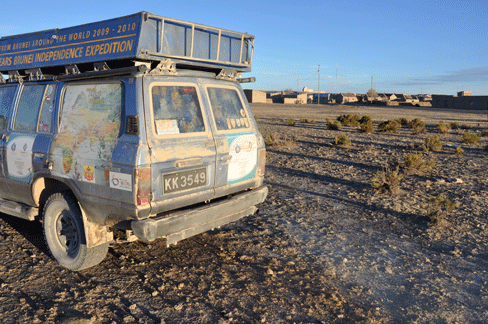
ice on the
windscreen
JAMBO warming up. Notice the smoke; in the
back the village
It was good we stopped as this morning we saw an actual meteorite
crater which fell from the sky and made a
500 m diameter carter.
Lots of black stones, meteorite material, much heavier than an
equal size rock, was lying around.
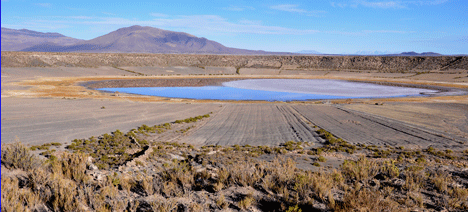
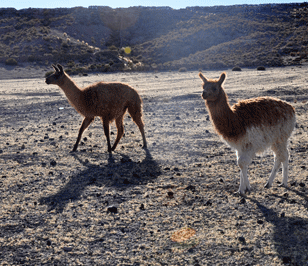
the crater, notice the rim and the impact
water pond
see the black meteorite material lying
around?
In the crater a water pool, partially ice. The locals have farmed
on the slopes. We took off in no time
after fueling some diesel from
a farmer, who charged only double. We had no information, when we
will reach a fuel station. Therefore safety
first.
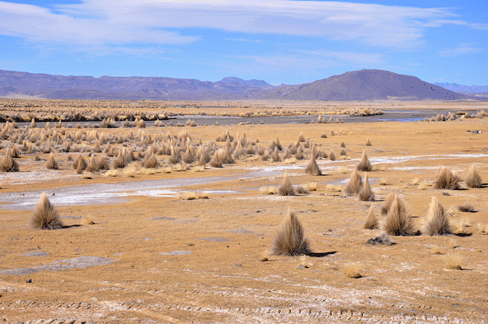
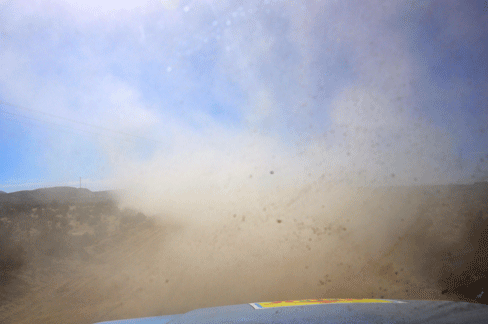
never touched by
a Llama
Dust on the road, not much to see
Somewhere we passed a field with grass bushels. Wondering why those
are not-as all others- nibbled away by lamas.
We investigated
and almost cut the skin. The grass has razor-sharp and hard edges.
That is how the plant defend itself from
being eaten.
It was after this dust field, we drove on the stony road again and
got the second puncture. A bigger hole, as
the air went out within a
few seconds. Yes we have two spare tiers, so we could change. But
it was the last one. Any more puncture we
had to open the tire
and repair our self. Vulcanizing material we had from Germany with
us.
The driving became very slowly and carefully. Again after about 40
km , we could
not see ahead any dust
clouds rising, usually our indicator of bad roads. One could see such
cloud over 20 km.
And finally our ordeal was over, we had hit a tarred road. How
happy we were, listening to the sound of our
tiers. No more hammering
and fear. Heavens thank you, we have now tarred road until La Paz.
In Oruro, a small town on route, we repaired
the two "flats". For
such holes he was not equipped. But we had our German tire repair
patches 5cm x 8 cm and they closed the
holes. Although hard
working. It took him one hour, while more and more locals gathered
around our vehicle and me explaining our
journey, showing where
Brunei is located. Mind you, no one understood me but all looked
respectfully at the maps and wondered from
which planet we were
coming. The tiers we will have to change. They made now since
Brunei over 65.000 km.
Perhaps in Peru.
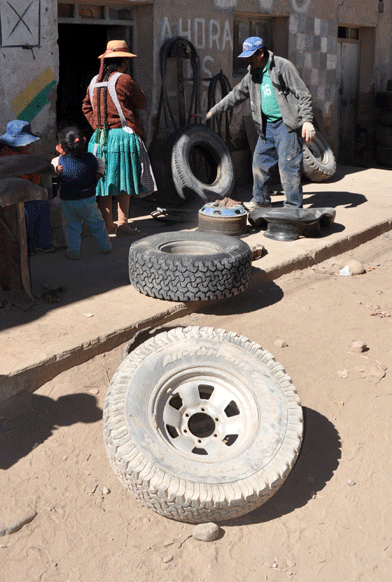
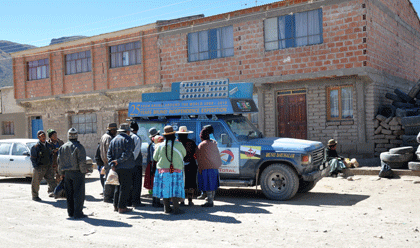
two punctures
The interested locals, and me in-between
It was 4:00 pm when we continued; only 200 km to La Paz. Carefully
driving among other vehicles we reached
around 7:00pm, the
road went down into the town lying only at 3,660 m. We found the
hotel which charges US$ 100.-/ night, parked
JAMBO in their
garage and fell after enjoying a ½ hour in hot bathtub into our
beds. Thank you ALMIGHTY!
MONDAY 21-6-2010
El
Paz the capital of Bolivia.
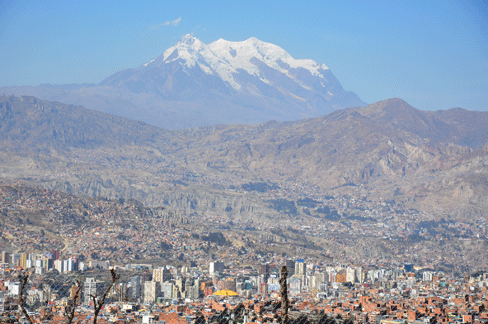
Surrounded by mountains the town lays
in a 800 m deep funnel like depression on
the feet of the giant 6400 m high Illimani.
A million
Bolivians live down here. When in
1553 the first Spaniards arrived were
Indians already washing gold on the
Choqueyapu - Gold seed-
river. Off course
the Spaniards organized soon the
professional way of gold extraction for
themselves. With it came the
foundation of
a town up on the plains,
where today the airport lies, "La Paz de Nuestra
Senora". But the
cold Altiplano wind (we experienced it)
made
it hard to get out of bed and onto
horsebacks. Therefore the decided in
1559 to establish the town down in the
valley where the
chilly wind would not
freeze one to the bones.
In 1586 only 260 Spaniards lived here but
already 6000 Aymara; seen as -so the
chronics tells-, humans though, but just
gotten out of
the animal shell.
In 1623 the Indians rebelled the first
time against colonialism, and more
followed over time.
The town did not earn her name La Paz (the Peace).
Opening the curtains we looked at the mountain slopes. Houses upon
houses. A million people live here. We will
stay a few days,
foremost that you dear reader is updated with the happening, then
JAMBO needs rear axle seals replaced as they
are leaking, we
have check the axle bearings which, because of hammering roads
might be worn-out. Lights have a slight
problem and adjusting
valves and injector pump, as the engine smokes. Wash JAMBO properly
as the salt of Salar Uyuni stick on the
chassis, corroding it
fast. Moreover tomorrow is the New year festivity of the natives,
the Aymara, of which Evo Morales Bolivia's
president is a son.


What one sees
from La Paz
Houses upon houses
Today is declared holiday. Nothing we cold
do with JAMBO. We went to Mercado de las
Brujas (the witch market), where most
tourist go. A town area on the slopes, where native culture and
medicine and remedies for any ailments,
hocus pocus is very alive.
There one finds the day tourists, junkies, but also real Indians,
living as such.
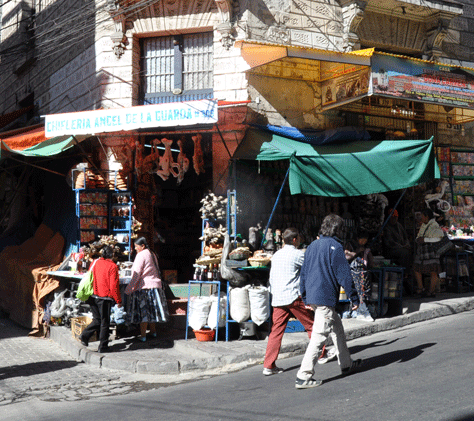
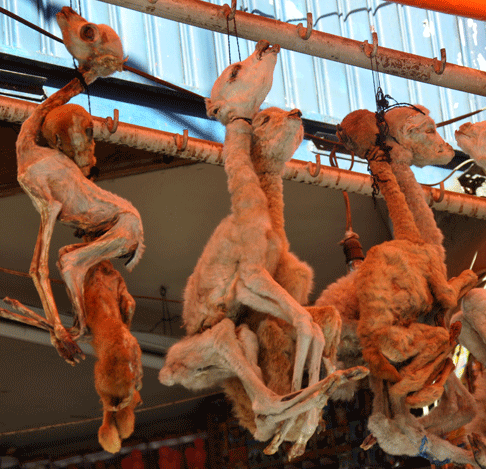
Mercado de las
Brujas
baby Llamas for rituals and sacrifice
Then the stands promising the "needy"
immediate cure of his, or her intimate
emotional or other problem. For instance,
dominion
over man, the best love making one ever had; if you only buy and
drink the tea. (And leave your money here.)
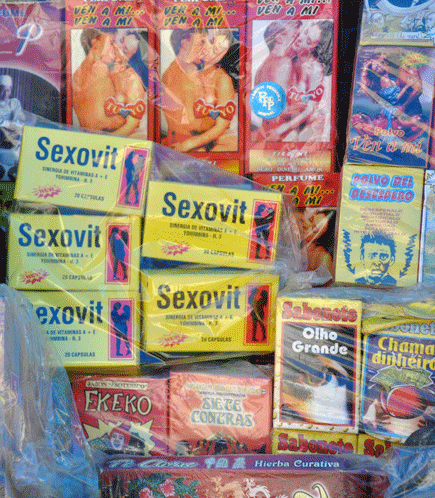
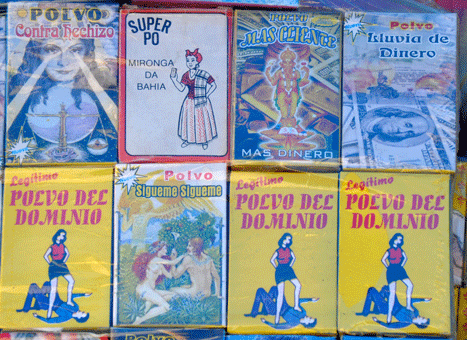
The
Aymara calenderer, passed down orally. Today
on the 21st June marks the year 5,518 of
Aymara culture. Lets know a bit more.
The Aymara do not have 12 moth and 4 seasons rather the year is
divided into two seasons. The winter
solstice and summer solstice.
The winter solstice ends precisely today. When dawn begins priests
meet with various offerings. Her in La Paz
the preparations
started much later and in full view of onlookers.
First women prepared the offerings, then placed them on a pile of
wood.
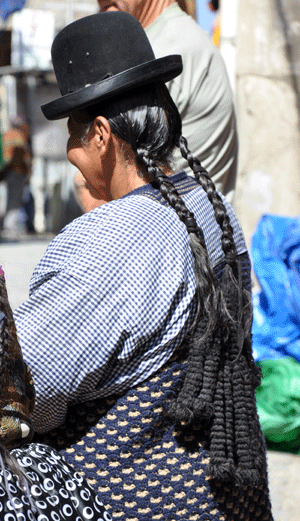

The women,
arranging the offerings had all very long
hair.
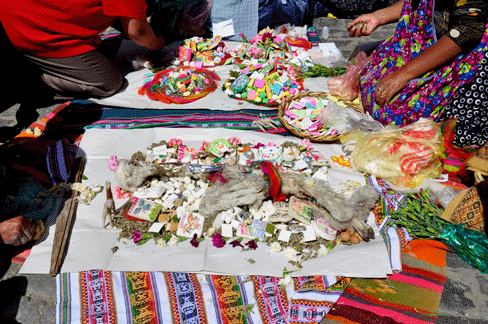
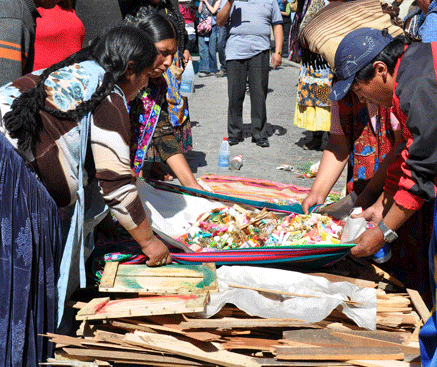
among spices and flowers a baby Lama
then the offerings are laid upon a woodpile

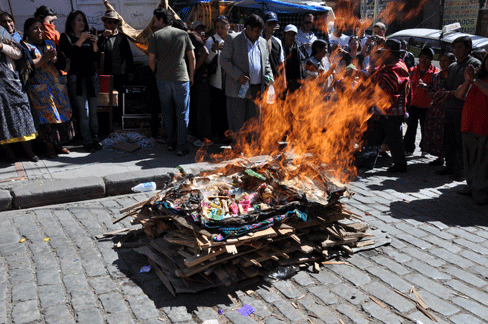
Some onlookers try to get away
The fire is on now the offerings pass into
another world
Then the priest, after saying prayers while waking around the pile
set fire protecting his face, as they had
poured spirit before.
A group of men dressed in ponchos circled the fire now while
playing music, with pan flute and drums. It
was a ceremonial
atmosphere.
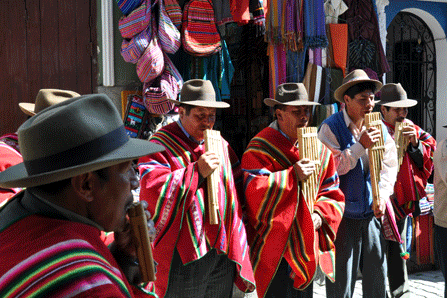
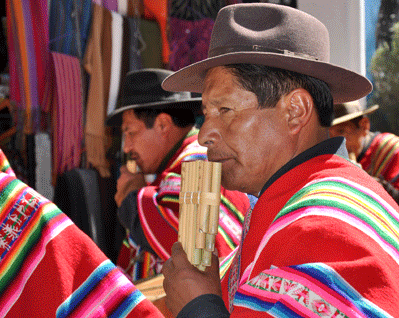
The Yatries
Musical group
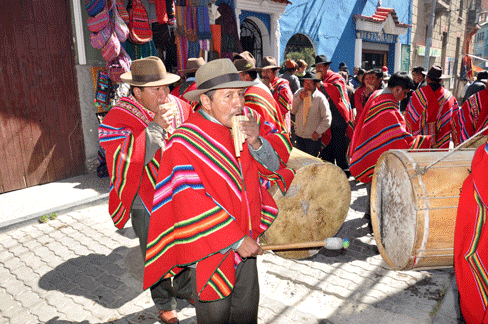
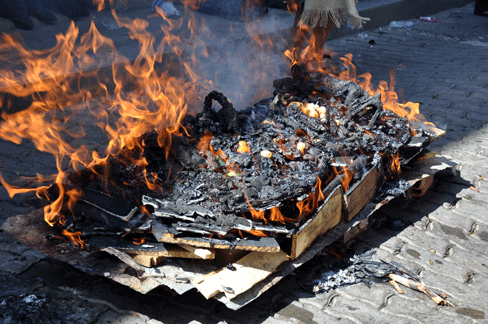
Playing their instruments and circled the fire, which slowly burned
down. Afterwards received everyone a free
meal, including us.
We offered our pork belly to some Dutch onlookers.
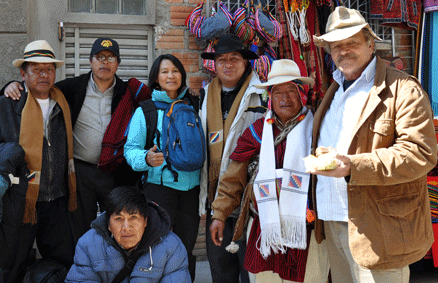
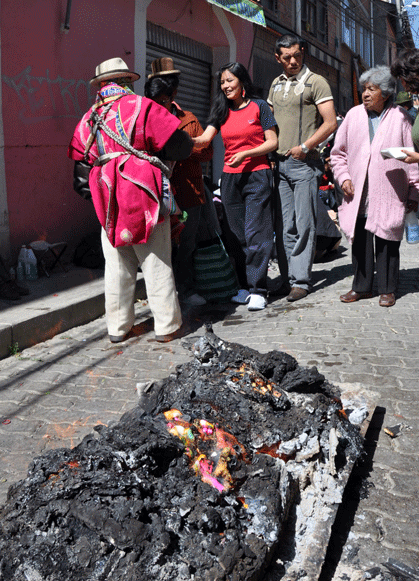
When the offerings were burned to
ashes, the attached wishes had safely
arrived in the world of spirits, we had made
the requested
memory photo, it was time to find a workshop for our JAMBO.
"Tomorrow morning by 10:00 am, a mechanic will come to the Hotel." Was the
receptionists message.
TUESDAY 22-6-2010
Here came a young boy with a small tool box. That was not agreeable
to us and we ask to go to the garage. Indeed
there was one,
full packed with repair cars. The boss seemed to be competent.
"Tonight by 6:00 pm you get your car". "That
was wishful thinking"
said Harun, knowing of the amount of work to be done. By 5:00pm we
phoned." Tomorrow by 10:00am the car is
ready"
The rest of the day we worked on the web site, as you can see.
WEDNESDAY 23-6-2010
By 9:00
we called. The car is ready by 10:30. It
was, but had cost us 2.100 Bolivanos, that is US$
340.-.

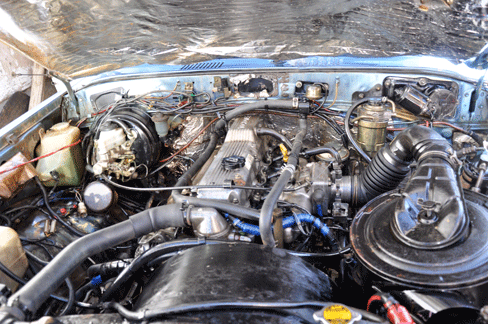
The boss and his team
even the engine was washed shiny afterwards
Out of la Paz, we drove on the Altiplano, the white Illimani
standing gracious on the horizon, before we
turned onto the peninsula
towards Copacabana.
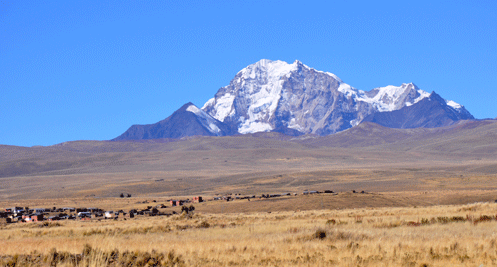
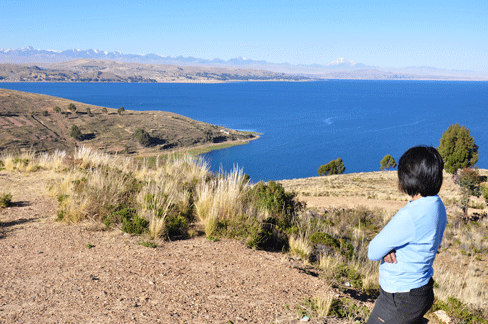
can the sky be
more blue?
the Titicaca lake, on the horizon the
Cordilleras
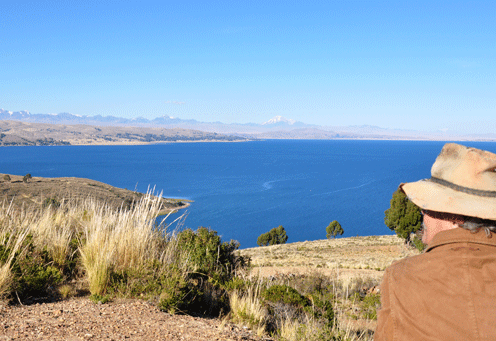
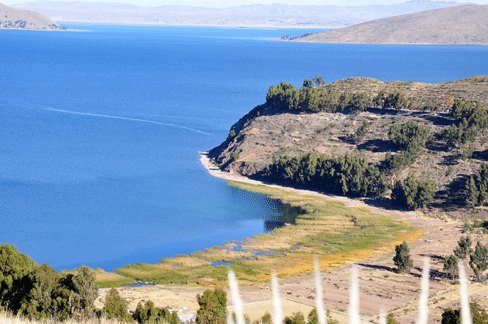 a place for reflection
with nesting bays and shores
a place for reflection
with nesting bays and shores
We arrived late afternoon in Copacabana the today tours village on
the Titicaca lake, 3856 m above sea
level. Our height sickness
symptoms are no
more and as such our well being and mood has
improved.
Lake Titicaca is the highest
navigate able lake on
the planet. The early cultures here on the Altiplano are dating back to 15.000 years.
In the Archeology of the Andes, the lake is
holy. The Tiwanaku culture, the mystery
of the Incas origin is interwoven with this
lake, as
in their mythology, the ancestors of the Incas
originated from The Sun Island. Up
here the sun warms the waters and influences
the
climate with its huge water mass. A respectable
area of about 8000 square kilometer. Since
thousand of years at his shores people
plant potatoes, beans, and maize. But it is
not known from where these people originated. The
ancestral home was maybe Asia
30.000 years
ago. Today around the lake live the Aymara,
the Quechua people, and at the floating
island the descendants of the Uru.
Their Totora boats made from reed are today only
build for the tourists as they rot
away within a year and one of plastic
last 10 times
that long.
Copacabana or Kgogba kawana as it is named
originally, was known for its fine beaches
and people settled here. It became
over time
a center of sanctuaries. Such a concentrated place of cults must become a
preferred hunting ground for missionaries.
To convert the
Indian "barbarians" to
everlasting and - in their eyes- only
rightful way to GOD, which is Christianity,
is a must.
The Augustinians build
their first chapel in the 17th
century.
An Inca of Royal blood, Tito Yupanqui,
became a monk and modeled the Madonna with
an Indian head. Soon it was rumored that she
performs miracles. Pilgrims arrived and
since the originally small chapel had not
enough space and importance, it was enlarged
and
became the Basilica, one see's today.
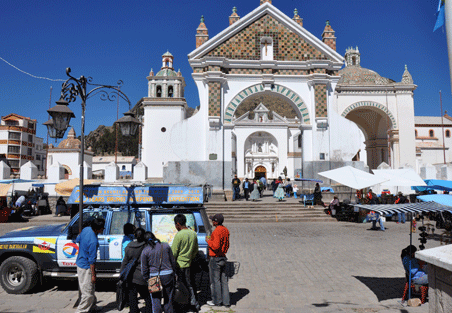
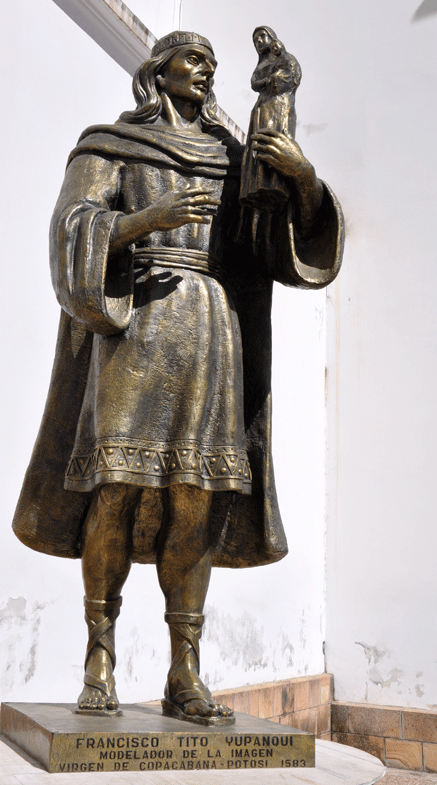
The basilica of Copacabana; people gather to
look at out journey
Tito, who modeled the Madonna
Every 5th August the Madonna is carried in a
procession around the town. Ringing bells
and pan flutes are played in joy.
The streets of Copacabana, are full of music and faith, believers
from afar joining the procession.
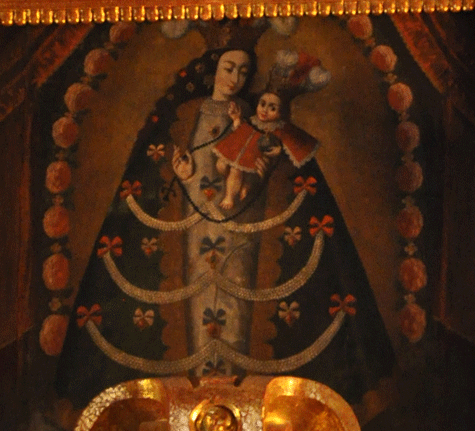

The virgin over the altar
and as a statue with flower and donation box
Believers come to pray, locals and tourists alike. The mighty
wooden entrance door is adorned with wood
carvings showing among
others, the virgin, protector of sailors and fishermen on the
Titicaca lake.
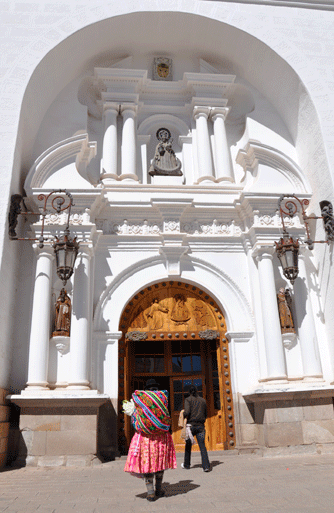
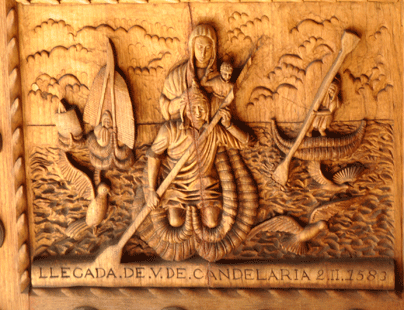
Indian Christians
the door carving
We had settled our JAMBO on the shores of the lake to sleep a
dreamless sleep.
THURSDAY 24-6-201
As
every day, the sun shone from a spotless
sky. In the morning breeze a Totora
reed boat rocked gentle in the wind.
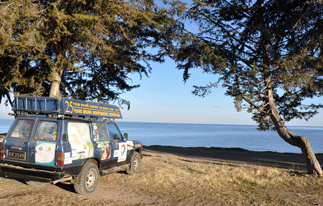
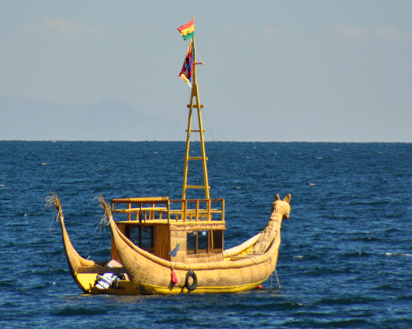
On the shores of the Titicaca lake
a reed boat
We had planned a visit of the Sun island and went early to the
port. But first Harun dipped into the holy
lake. To proof that the freezing
cold is no hindrance for a "refreshing" bath. Afterwards it was
time to join the tourists for a ride to Sun
island.
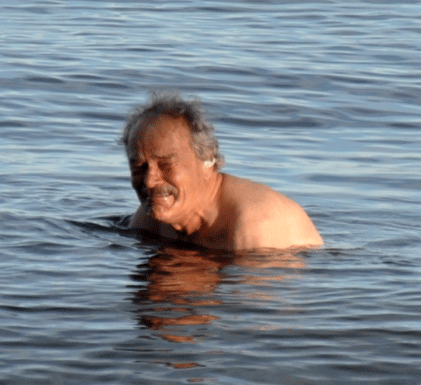
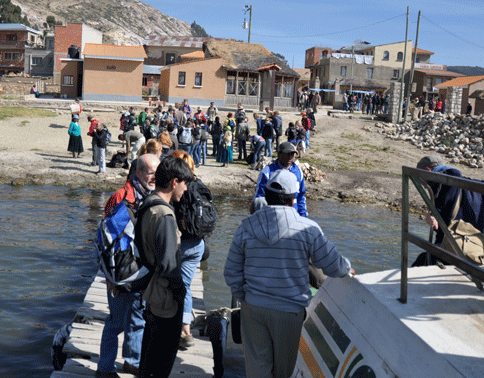
"all sins forgiven"
we among the backpacker tourists
There are several boats to the island with three stops. We did not
know what is going to happen when we entered
the boat.
In summary maybe a 100 tourists, the out flipped, the serious "I
need to see this too" travelers, the
hippies, junkies, often girls of
European decent with long, unwashed hair plaited in
pigtails, in the usual comfortable colorful
Inca dresses.
Half of their young life on a Marihuana trip,
the other half perhaps searching for money, if needed with their
body.
How meaningless.
In fact we were approached by two women since our "JAMBO" was on
the shore. "If we would need some grass"
We gentle declined.
So, we sailed out with 40 others from the Copacabana bay and to the
North End of SUN ISLAND. "Stop here is 3
hours.
Who want can hike back to Yumani in the southern Zone or, climb up
to CHINCANA only 40 minutes away."
But how to do this? When 10 stairs made us breathless.
The captain steered the ship with his foot and listen to the radio,
that he may not sleep during the 1½ hour
journey.
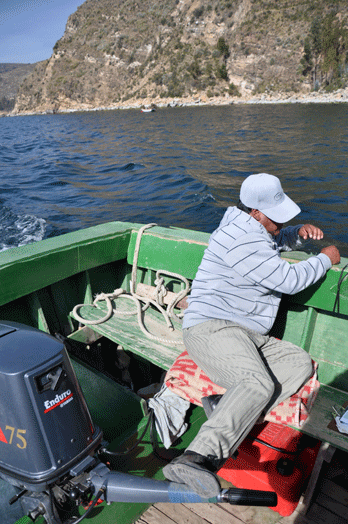
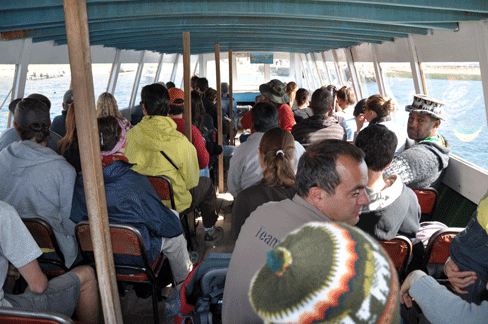
The first three hours we went to see
the agriculture field which leveled out
along the shores.
When the Incas on the 15th century occupied the Isla del Sol this
10 km long Island, they realized that they
had stepped on holy
ground. A rock in the Northwest was, back in the dark ages the
house of the sun, before she rose up to the
firmament, to send the first
INCAS, Mancs Capac and Mama Ocllo back to earth. The rock was
adorned with gold and silver foils as a holy
shrine untouchable for
all pilgrims. Several complexes are located on the sun island.
CHINCANA or PILKO KAINA are two, from where
the cordilleras are
visible with the majestic and honored mountain, ILLAMPU, the
seat of all gods.
What wonders than in the mystical world of fishermen, on finds
tales of towns, resting in the deep, and
crash-landing UFO's.
Jacques Cousteau went after these fables and dived down to the
bottom. But he found nothing. However in
1979, divers discovered
north of the island under water walls, and rescued ceramic and gold
works.
In the year 2000, a 200 m long and 50m wide temple was
discovered too.
Who knows, maybe the Titicaca lake is perhaps a place where
extraterrestrials meet, after all he is 200
km long.
Maybe the waters protect still many mysteries.
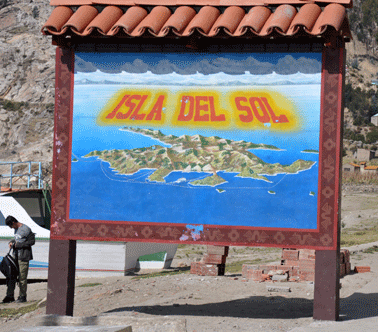
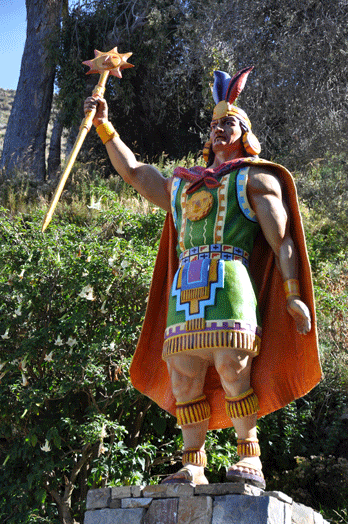
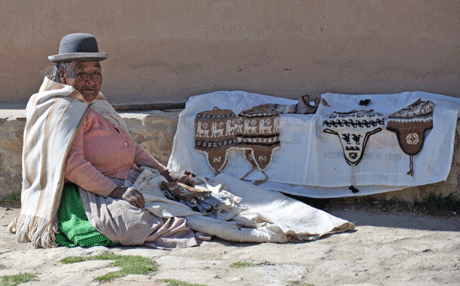
a signboard of the island
a Inca king in heroic pose
and a Mama, waiting for tourist money
In
a protected cove we found this ship, made as
1000 years ago. Today she sails with
tourists, if there is only favorable wind!
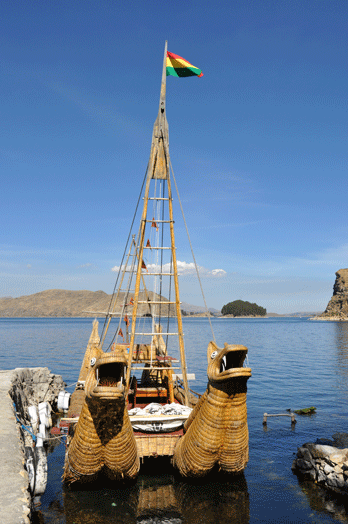

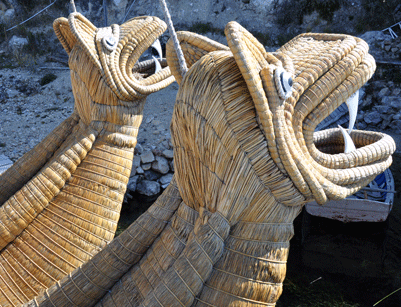
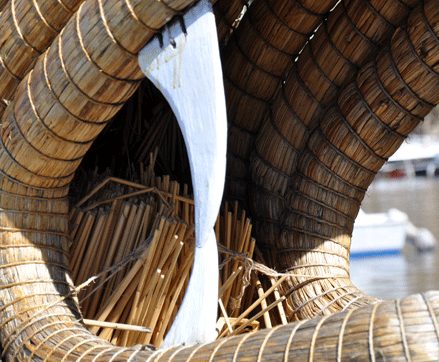
In the dragons throat rises the reed. The hulls were filled with
reed material completely and finally on the
outside bundled with strings.
Wandering along the shores we came to an football field which was
converted into a drying place for potatoes.
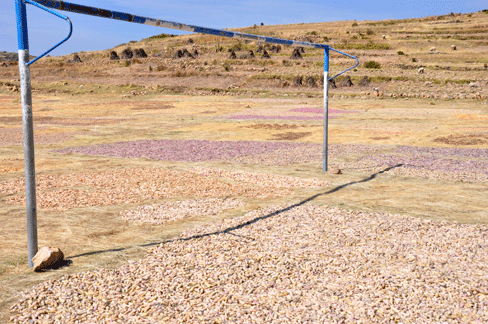
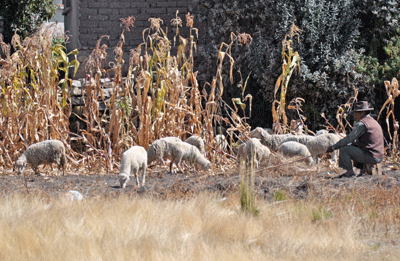
Passing an Indian who watched over his
flock of sheep. Behind a maize field; as we
know, our maize originated here in South
America. Further down, women harking the field and harvesting
potatoes, in a way as it was done since
centuries. I helped for 10
minutes harking and picking them, one by one. Believe me it was
hardship in 3.800 m height in the direct
sunlight!
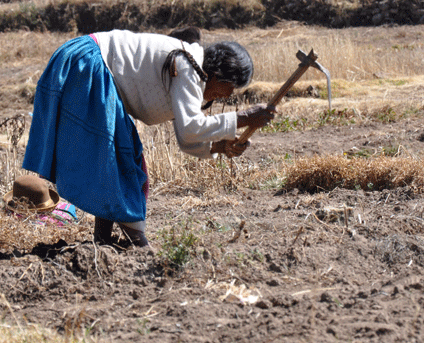

No mechanical tool; just as their ancestors,
they still work today.
We
took another boat back to Copacabana and
reached around 5:00 pm. Nothing eaten the
whole day. Therefore we settled in a
beach restaurant, catering for backpackers. Cheap. They also know
the business secret as indicated on a
poster.
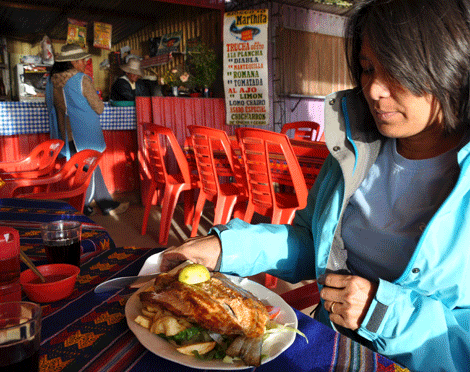
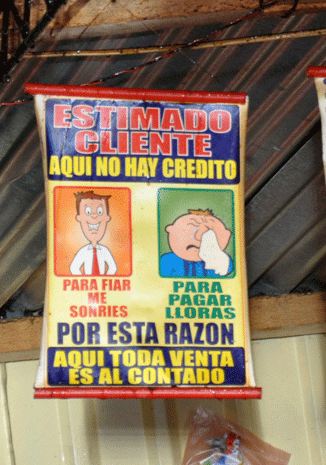
A Titicaca trout; I had to taste
Bolivian business secret
We went to bed as usual ,in " Hotel de la JAMBO" on the beach of
Titicaca lake.
FRIDAY 25-6-2010
Glorious the sun rose over the mountain rim around 8:00 am.
Immediately the air warms up. We had decided
to stay today, as there a
hotel with internet. Heaven knows, when in Peru, our next country,
we will have the chance again.
Wandering a bit around in the town, I met the kid hopping between
the layout stones, just as we did when we
were children.
Note the attractive stockings the Indian ladies wear.
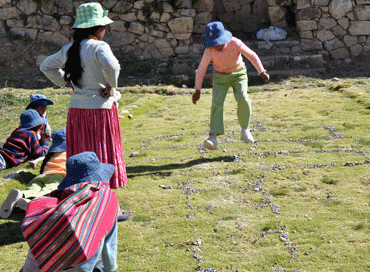
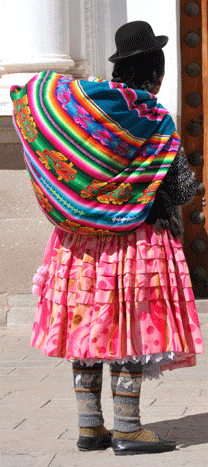
Chola Dress
The evening was approaching and the sun set as every day since the
time she left the rock on sun island behind
the Titicaca lake.
In the bay the boats throw long shadows and we thought of tomorrow.
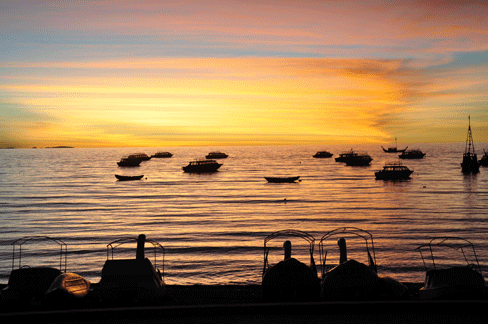
Our time in Bolivia has ended. Tomorrow we will enter Peru, where
our northbound journey continues. Until we
meet again.
SATURDAY 26-6-2010
We are on
route to Peru and if you like click
Peru where our expedition continues.
|